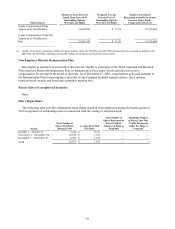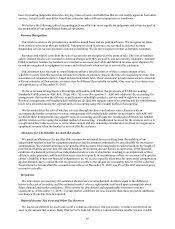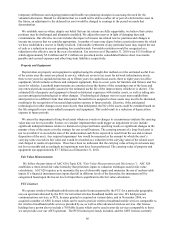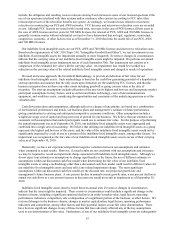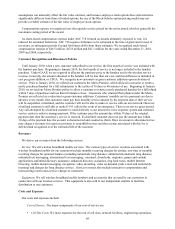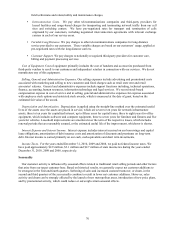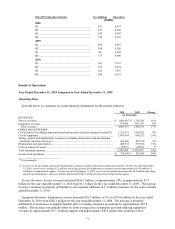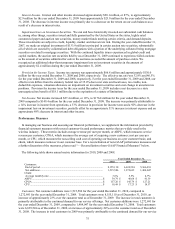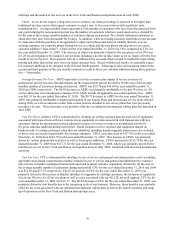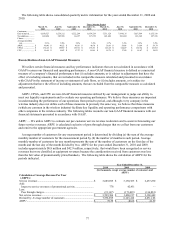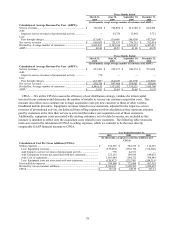Metro PCS 2010 Annual Report Download - page 78
Download and view the complete annual report
Please find page 78 of the 2010 Metro PCS annual report below. You can navigate through the pages in the report by either clicking on the pages listed below, or by using the keyword search tool below to find specific information within the annual report.
68
determined to have a finite useful life, we would test such assets for impairment in accordance with ASC 360 (Topic
360, “Property, Plant, and Equipment”), and the intangible assets would then be amortized prospectively over the
estimated remaining useful life.
For the license impairment test performed as of September 30, 2010, the aggregate fair value of the indefinite-
lived intangible assets was in excess of the aggregate carrying values. There also have been no subsequent
indicators of impairment, including those indicated in ASC 360, and accordingly no subsequent interim impairment
tests were performed.
Share-Based Payments
We account for share-based awards exchanged for employee services in accordance with ASC 718 (Topic 718,
“Compensation – Stock Compensation”). Under ASC 718, share-based compensation cost is measured at the grant
date, based on the estimated fair value of the award, and is recognized as expense over the employee’s requisite
service period.
We have granted restricted stock awards that entitle the holder to receive shares of common stock which become
fully tradable upon vesting. The restricted stock awards granted generally vest on a four-year vesting schedule with
25% vesting on the first anniversary date of the award and the remainder pro-rata on a monthly or quarterly basis
thereafter, subject to a service condition that relates only to vesting. The estimated compensation expense, which is
equal to the fair value of the awards on the date of grant, is recognized on a straight-line basis over the vesting
period.
We have also granted nonqualified stock options. Most of our stock option awards include a service condition
that relates only to vesting. The stock option awards generally vest in one to four years from the grant date with 25%
vesting on the first anniversary date of the award. Compensation expense is amortized on a straight-line basis over
the requisite service period for the entire award, which is generally the maximum vesting period of the award.
The determination of the fair value of stock options using an option-pricing model is affected by our common
stock valuation as well as assumptions regarding a number of complex and subjective variables. The Board of
Directors uses the closing price of our common stock on the date of grant as the fair market value for our common
stock. The volatility assumption is based on a combination of the historical volatility of our common stock and the
volatilities of similar companies over a period of time equal to the expected term of the stock options. The
volatilities of similar companies are used in conjunction with our historical volatility because of the lack of
sufficient relevant history equal to the expected term. The expected term of employee stock options represents the
weighted-average period the stock options are expected to remain outstanding. The expected term assumption is
estimated based primarily on the stock options’ vesting terms and remaining contractual life and employees’
expected exercise and post-vesting employment termination behavior. The risk-free interest rate assumption is based
upon observed interest rates on the grant date appropriate for the term of the employee stock options. The dividend
yield assumption is based on the expectation of no future dividend payouts by us.
The value of the options is determined by using a Black-Scholes pricing model that includes the following
variables: 1) exercise price of the instrument, 2) fair market value of the underlying stock on date of grant,
3) expected life, 4) estimated volatility and 5) the risk-free interest rate. We utilized the following weighted-average
assumptions in estimating the fair value of the options grants for the years ended December 31, 2010 and 2009:
December 31,
2010
December 31,
2009
Expected dividends ..................................................................................................... 0.00% 0.00%
Expected volatility ...................................................................................................... 54.74% 50.01%
Ris
k
-free interest rate ................................................................................................. 2.24% 1.99%
Expected lives in years ............................................................................................... 5.00 5.00
Weighte
d
-average fair value of options:
Granted at fair value .................................................................................................. $ 3.23 $ 6.43
Weighte
d
-average exercise price of options:
Granted at fair value .................................................................................................. $ 6.62 $ 14.23
The Black-Scholes model requires the use of subjective assumptions including expectations of future dividends
and stock price volatility. Such assumptions are only used for making the required fair value estimate and should not
be considered as indicators of future dividend policy or stock price appreciation. Because changes in the subjective






